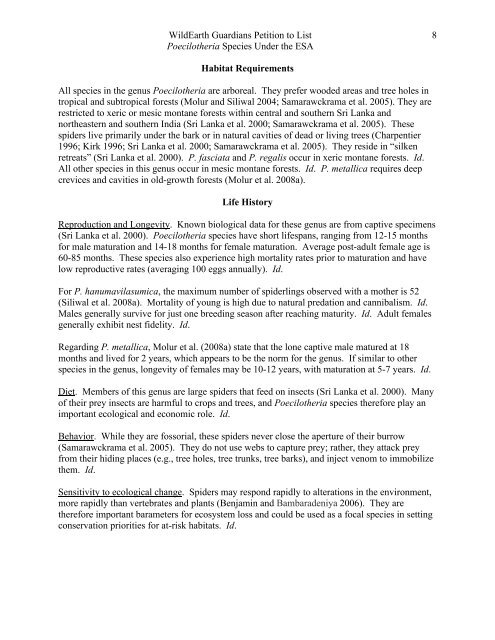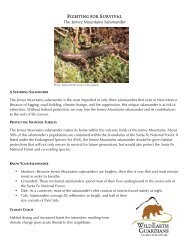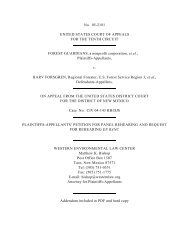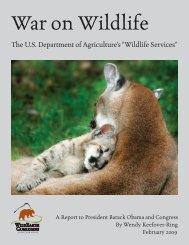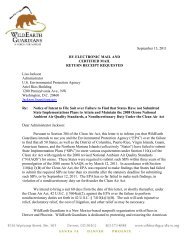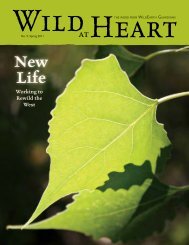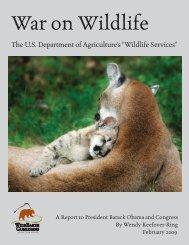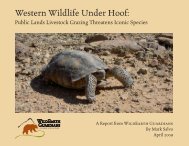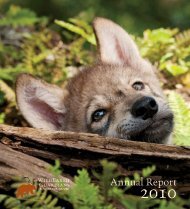Tarantulas Petition - WildEarth Guardians
Tarantulas Petition - WildEarth Guardians
Tarantulas Petition - WildEarth Guardians
Create successful ePaper yourself
Turn your PDF publications into a flip-book with our unique Google optimized e-Paper software.
!<br />
<strong>WildEarth</strong> <strong>Guardians</strong> <strong>Petition</strong> to List<br />
Poecilotheria Species Under the ESA<br />
Habitat Requirements<br />
8!<br />
All species in the genus Poecilotheria are arboreal. They prefer wooded areas and tree holes in<br />
tropical and subtropical forests (Molur and Siliwal 2004; Samarawckrama et al. 2005). They are<br />
restricted to xeric or mesic montane forests within central and southern Sri Lanka and<br />
northeastern and southern India (Sri Lanka et al. 2000; Samarawckrama et al. 2005). These<br />
spiders live primarily under the bark or in natural cavities of dead or living trees (Charpentier<br />
1996; Kirk 1996; Sri Lanka et al. 2000; Samarawckrama et al. 2005). They reside in “silken<br />
retreats” (Sri Lanka et al. 2000). P. fasciata and P. regalis occur in xeric montane forests. Id.<br />
All other species in this genus occur in mesic montane forests. Id. P. metallica requires deep<br />
crevices and cavities in old-growth forests (Molur et al. 2008a).<br />
Life History<br />
Reproduction and Longevity. Known biological data for these genus are from captive specimens<br />
(Sri Lanka et al. 2000). Poecilotheria species have short lifespans, ranging from 12-15 months<br />
for male maturation and 14-18 months for female maturation. Average post-adult female age is<br />
60-85 months. These species also experience high mortality rates prior to maturation and have<br />
low reproductive rates (averaging 100 eggs annually). Id.<br />
For P. hanumavilasumica, the maximum number of spiderlings observed with a mother is 52<br />
(Siliwal et al. 2008a). Mortality of young is high due to natural predation and cannibalism. Id.<br />
Males generally survive for just one breeding season after reaching maturity. Id. Adult females<br />
generally exhibit nest fidelity. Id.<br />
Regarding P. metallica, Molur et al. (2008a) state that the lone captive male matured at 18<br />
months and lived for 2 years, which appears to be the norm for the genus. If similar to other<br />
species in the genus, longevity of females may be 10-12 years, with maturation at 5-7 years. Id.<br />
Diet. Members of this genus are large spiders that feed on insects (Sri Lanka et al. 2000). Many<br />
of their prey insects are harmful to crops and trees, and Poecilotheria species therefore play an<br />
important ecological and economic role. Id.<br />
Behavior. While they are fossorial, these spiders never close the aperture of their burrow<br />
(Samarawckrama et al. 2005). They do not use webs to capture prey; rather, they attack prey<br />
from their hiding places (e.g., tree holes, tree trunks, tree barks), and inject venom to immobilize<br />
them. Id.<br />
Sensitivity to ecological change. Spiders may respond rapidly to alterations in the environment,<br />
more rapidly than vertebrates and plants (Benjamin and Bambaradeniya!2006). They are<br />
therefore important barameters for ecosystem loss and could be used as a focal species in setting<br />
conservation priorities for at-risk habitats. Id.<br />
! ! !<br />
!


